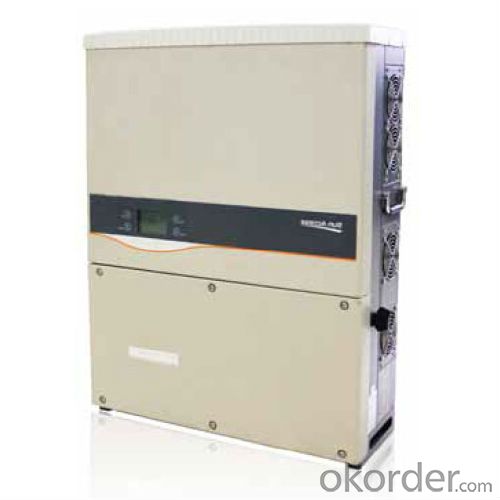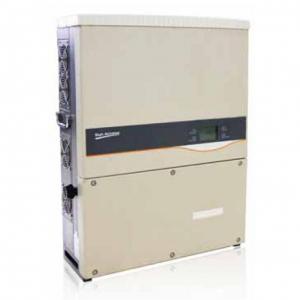Photovoltaic Grid-Connected Inverter SG40KTL
- Loading Port:
- China Main Port
- Payment Terms:
- TT or LC
- Min Order Qty:
- 50 unit
- Supply Capability:
- 10000 unit/month
OKorder Service Pledge
OKorder Financial Service
You Might Also Like
1. Structure of Photovoltaic Grid-Connected Inverter SG40KTL Description
A solar inverter, or PV inverter, or Solar converter, converts the variable direct current (DC) output of a photovoltaic (PV) solar panel into
autility frequency alternating current (AC) that can be fed into a commercial electrical grid or used by a local, off-grid electrical network.
It is acritical BOS–component in a photovoltaic system, allowing the use of ordinary AC-powered equipment.
Solar inverters have special functions adapted for use with photovoltaic arrays, including maximum power point tracking and anti-islanding protection.
Suitable for 50Hz/60Hz grid, could be used in Asia, Africa and Europe. Available for hand installation, no need for lifting machinery
assistance.
2. Main Features of the Photovoltaic Grid-Connected Inverter SG40KTL
• Full 36kW effective power at power factor of 0.9 due to apparent power reserves up to 39.8kVA
• Max. Efficiency at 98.3%
• Dual MPP trackers control
• Reduced cabling on AC side due to higher output voltage of 480Vac
• Integrated combiner box: 8 x MC4 connector pairs with DC string fuses, Type II overvoltage protection and DC switch, more safety and lower the system cost
• Can be wall-mounted without lifting equipment, weight 65 kg
• Active power continuously adjustable (0~100%)
• Reactive power control with power factor 0.8 overexcited ~ 0.8 underexcited
• Includes RS-485 interface, compatible with all common monitoring systems
• Product certification: TÜV, BDEW and CGC
• Manufacturer certification: ISO 9001, ISO 14001, OHSAS 18000
3. Photovoltaic Grid-Connected Inverter SG40KTL Images



4. Photovoltaic Grid-Connected Inverter SG40KTL Specification
Input Side Data | |
Max. PV input power | 40500W |
Max. PV input voltage | 1000V |
Startup voltage | 300V |
Nominal input voltage | 710V |
MPP voltage range | 280~950V |
MPP voltage range for nominal power | 560~800V |
No. of MPPTs | 2 |
Max. number of PV strings per MPPT | 4 |
Max. PV input current | 66A(33A/33A) |
Max. current for input connector | 12A |
Output Side Data | |
Nominal AC output power | 36000W |
Max AC output power(PF=1) | 39800W |
Max. AC output apparent power | 39800VA |
Max. AC output current | 48A |
Nominal AC voltage | 3/N/PE, 277/480Vac or 3/PE, 480Vac |
AC voltage range | 422~528Vac |
Nominal grid frequency | 50Hz/60Hz |
Grid frequency range | 45~55Hz/55~ 65Hz |
THD | < 3 % (Nominal power) |
DC current injection | <0.5 %In |
Power factor | >0.99@default value at nominal power |
(adj. 0.8overexcited ~0.8underexited) | |
Protection | |
Anti-islanding protection | Yes |
LVRT | Yes |
DC reverse connection protection | Yes |
AC short circuit protection | Yes |
Leakage current protection | Yes |
DC switch | Yes |
DC fuse | Yes |
Overvoltage protection | DC Type II DIN rail surge arrester(40KA) |
System Data | |
Max. efficiency | 98.30% |
Max. European efficiency | 98.00% |
Isolation method | Transformerless |
Ingress protection rating | IP65 |
Night power consumption | <1W |
Operating ambient temperature range | -25~60℃(>45℃ derating) |
Allowable relative humidity range | 0~100% |
Cooling method | Smart forced air cooling |
Max. operating altitude | 4000m (>3000m derating) |
Display | Graphic LCD |
Communication | RS485(RJ45 connector) |
DC connection type | MC4 |
AC connection type | Screw Clamp terminal |
Certification | VDE0126-1-1, EN62109-1, EN62109-2,BDEW, |
CGC, NRS 097-2-1, GB/T 19964, UTE C15-712-1 | |
IEC 61683, IEC 60068-2, IEC61727, IEC62116, | |
IEC62109-1, IEC62109-2, EN50178, IEC62103, | |
EN61000-6-1, EN61000-6-2, EN61000-6-3, EN61000-6-4 | |
Mechanical Data | |
Dimensions(W×H×D) | 634×820×257mm |
Mounting method | Wall bracket |
Weight | 65kg |
5. FAQ of Photovoltaic Grid-Connected Inverter SG40KTL
Q1. What is the difference between inverter and solar inverter?
A1. Inverter only has AC inpput, but solar inverter both connect to AC input and solar panel, it saves more power.
Q2. What is the difference between MPPT&PWM?
A2. MPPT has higher efficiency, it can track the max power point and won't waste energy.
- Q:How long do solar inverters typically last?
- Solar inverters typically have a lifespan of 10 to 15 years, but this can vary depending on factors such as quality, maintenance, and usage.
- Q:How does a solar inverter handle variations in ambient temperature?
- A solar inverter handles variations in ambient temperature by incorporating temperature compensation mechanisms. These mechanisms allow the inverter to adjust its operation and optimize performance based on the temperature conditions. By monitoring the temperature, the inverter can regulate voltage levels, adjust power outputs, and protect itself from overheating. This ensures that the inverter operates efficiently and reliably under different ambient temperature conditions.
- Q:How do you troubleshoot common issues with a solar inverter?
- To troubleshoot common issues with a solar inverter, start by checking the connections and ensuring they are secure and undamaged. Verify that the DC input and AC output are receiving power properly. If there is no power, check the circuit breakers and fuses. It's also important to inspect the solar panels for any shading or debris that may affect their performance. Additionally, reviewing the error codes or indicators on the inverter can provide valuable insights into the problem. If the issue persists, consulting the manufacturer's manual or contacting a professional solar technician would be recommended for further troubleshooting and repair.
- Q:What is the expected lifespan of a solar inverter?
- The expected lifespan of a solar inverter can vary depending on several factors such as the quality of the equipment, usage patterns, and maintenance. On average, a well-maintained solar inverter can last between 10 to 15 years. However, some high-quality inverters have been known to last up to 20 years or more. Regular maintenance and monitoring can help prolong the lifespan of the inverter and ensure optimal performance throughout its lifespan.
- Q:How does a solar inverter protect against overvoltage?
- A solar inverter protects against overvoltage by continuously monitoring the voltage levels of the solar panels. If the voltage exceeds a certain threshold, the inverter automatically reduces the power output or disconnects from the grid to prevent damage to the system and ensure the safety of the electrical components.
- Q:What is the maximum number of solar panels that can be connected to a solar inverter?
- The maximum number of solar panels that can be connected to a solar inverter depends on various factors such as the power rating of the inverter, the voltage and current ratings of the solar panels, and the configuration of the solar array. It is typically recommended to consult the manufacturer's specifications or guidelines to determine the maximum number of panels that can be connected to a specific solar inverter.
- Q:Can a solar inverter be used in remote areas?
- Yes, a solar inverter can be used in remote areas. Solar inverters are designed to convert the direct current (DC) generated by solar panels into alternating current (AC) that can be used to power electrical devices. As long as there is access to sunlight, solar panels can be installed in remote areas to generate electricity, and the solar inverter can then be used to convert and distribute that power for various applications. This makes solar inverters a useful and sustainable solution for remote areas that may not have access to grid electricity.
- Q:Are solar inverters compatible with different solar panel technologies?
- Yes, solar inverters are generally compatible with different solar panel technologies. However, it is important to ensure that the inverter's specifications and capabilities align with the specific requirements of the solar panels being used. Some inverters may be optimized for certain panel technologies, so it's advisable to consult with manufacturers or experts to ensure compatibility and maximize system efficiency.
- Q:How does a solar inverter handle reactive power compensation?
- A solar inverter handles reactive power compensation by utilizing reactive power control techniques. It can dynamically regulate the amount of reactive power injected into or absorbed from the electrical grid. This helps maintain the power factor at the desired level, improving system efficiency and reducing grid instability caused by reactive power fluctuations.
- Q:What is the efficiency of a solar inverter?
- The efficiency of a solar inverter refers to how effectively it converts the direct current (DC) power generated by solar panels into alternating current (AC) power that can be used to power household appliances or be fed back into the grid. It is typically measured as a percentage and represents the amount of DC power that is successfully converted into usable AC power. A higher efficiency indicates a more effective conversion process, resulting in less energy loss and maximizing the overall output of the solar system.
1. Manufacturer Overview |
|
|---|---|
| Location | |
| Year Established | |
| Annual Output Value | |
| Main Markets | |
| Company Certifications | |
2. Manufacturer Certificates |
|
|---|---|
| a) Certification Name | |
| Range | |
| Reference | |
| Validity Period | |
3. Manufacturer Capability |
|
|---|---|
| a)Trade Capacity | |
| Nearest Port | |
| Export Percentage | |
| No.of Employees in Trade Department | |
| Language Spoken: | |
| b)Factory Information | |
| Factory Size: | |
| No. of Production Lines | |
| Contract Manufacturing | |
| Product Price Range | |
Send your message to us
Photovoltaic Grid-Connected Inverter SG40KTL
- Loading Port:
- China Main Port
- Payment Terms:
- TT or LC
- Min Order Qty:
- 50 unit
- Supply Capability:
- 10000 unit/month
OKorder Service Pledge
OKorder Financial Service
Similar products
New products
Hot products
Related keywords

































